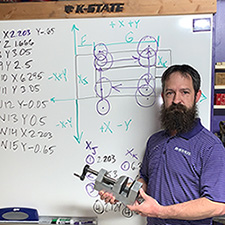May 6, 2020
Long-held tradition of vise manufacturing continues with switch to online learning

Timothy Deines, senior instructor in the industrial and manufacturing systems engineering department, has moved to online instruction for his Manufacturing Processes Lab, IMSE 251, an undergraduate course he teaches six, three-hour sections of per week, with 16 students in each section who attend the lab once a week.
"The lab focuses on introducing basic manufacturing processes," Deines said. "Students spend three weeks green-sand-casting parts for a drill-press vise — a project engineering students have been tackling at K-State since the 1940s with very few changes to the design over the years.
"They spend one week experiencing shielded metal-arc welding, gas metal-arc welding, gas tungsten-arc welding and spot welding. One week is spent learning how to use micrometers and other measuring instruments, and the remaining 10 weeks are spent manually machining cast parts and raw stock to manufacture their vise."
In a normal on-campus semester, students will learn the basic concept of G and M codes that command the computer numerical control, or CNC, Haas milling machine in the lab. G codes tend to deal with geometry and M codes with machine configuration.
"I have been recording lectures at my house, and then posting them on Canvas, to instruct students virtually on how to write G and M Code for the Haas CNC mill," Deines said. "I also upload video of each machining operation so they still have involvement in manufacturing their vise even though they aren't doing it hands-on themselves.
"I have moved the focus of the lab from mainly manual machining to the CNC machining, and students are given the measurements of their castings for the vise."
By starting out with having them submit Z, or zero, values for the first operation and moving on to each consecutive code requiring additional information be submitted, by the end of the semester, Deines' expectation is that all should be able to manually write the code themselves to machine the last few operations on the project.
"Students will ultimately have sent me their entire code for a vise," he said. "I will review each, and then run the parts with these codes on the CNC mill once we can go back to campus and the lab. Each person will get the drill press vise he or she wrote the code for, whether it's later this summer or next fall."
Deines has also been holding office hours using Zoom, where students can attend and ask any questions.
"Zoom has the ability to allow students to share their computer screens with me," he said, "so I can look at their code as the lab progresses and help them correct it if needed."
